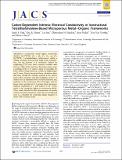Cation-Dependent Intrinsic Electrical Conductivity in Isostructural Tetrathiafulvalene-Based Microporous Metal–Organic Frameworks
Author(s)
Hendon, Christopher H.; Walsh, Aron; Park, Sarah Sunah; Hontz, Eric Richard; Sun, Lei; Van Voorhis, Troy; Dinca, Mircea; ... Show more Show less
DownloadDinca_Cation-dependent.pdf (1.215Mb)
PUBLISHER_POLICY
Publisher Policy
Article is made available in accordance with the publisher's policy and may be subject to US copyright law. Please refer to the publisher's site for terms of use.
Terms of use
Metadata
Show full item recordAbstract
Isostructural metal–organic frameworks (MOFs) M[subscript 2](TTFTB) (M = Mn, Co, Zn, and Cd; H[subscript 4]TTFTB = tetrathiafulvalene tetrabenzoate) exhibit a striking correlation between their single-crystal conductivities and the shortest S···S interaction defined by neighboring TTF cores, which inversely correlates with the ionic radius of the metal ions. The larger cations cause a pinching of the S···S contact, which is responsible for better orbital overlap between pz orbitals on neighboring S and C atoms. Density functional theory calculations show that these orbitals are critically involved in the valence band of these materials, such that modulation of the S···S distance has an important effect on band dispersion and, implicitly, on the conductivity. The Cd analogue, with the largest cation and shortest S···S contact, shows the largest electrical conductivity, σ = 2.86 (±0.53) × 10[subscript –4] S/cm, which is also among the highest in microporous MOFs. These results describe the first demonstration of tunable intrinsic electrical conductivity in this class of materials and serve as a blueprint for controlling charge transport in MOFs with π-stacked motifs.
Date issued
2015-01Department
Massachusetts Institute of Technology. Department of ChemistryJournal
Journal of the American Chemical Society
Publisher
American Chemical Society (ACS)
Citation
Park, Sarah S. et al. “Cation-Dependent Intrinsic Electrical Conductivity in Isostructural Tetrathiafulvalene-Based Microporous Metal–Organic Frameworks.” Journal of the American Chemical Society 137.5 (2015): 1774–1777. © 2015 American Chemical Society
Version: Final published version
ISSN
0002-7863
1520-5126